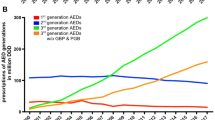Summary
When monitoring of the plasma concentrations of anticonvulsant drugs first came into use 25 years ago, it appeared to have a major impact on improving the effectiveness and safety of anticonvulsant therapy. However, as time has passed, prescribers have absorbed many of the lessons to be learned from the monitoring, and now apply this knowledge without necessarily monitoring plasma anticonvulsant concentrations as frequently as in the past. Therefore, the effect of the drug concentration monitoring on the cost effectiveness of anticonvulsant therapy is probably not as significant now as it originally was.
In theory, drug concentration monitoring is often unlikely to decrease the cost of contemporary anticonvulsant drug therapy, but it may enhance the efficacy of the therapy. Thus, monitoring may reveal unrecognised under- or overdosage, detect failure of compliance or drug-drug interactions, or indicate when there is little point in persisting with a particular anticonvulsant drug.
Despite a good deal of anecdotal testimony, surprisingly little has been published demonstrating the benefits of anticonvulsant therapeutic drug monitoring in epileptic populations. However, one study did show better rates of Scizure control rates in patients monitored in the first 6 months of their epileptic disorder; but not if the monitoring began later than this.
Under conditions of contemporary practice, monitoring appears to be most advantageous under the following conditions: (i) while Scizure control is being established in a patient; (ii) if Scizures are no longer being controlled by therapy; (iii) if adverse effects that are possibly treatment-related occur; (iv) if a concomitant illness develops; (v) if there is a change in a patient’s physiological state, e.g. pregnancy; and (vi) prior to the withdrawal of therapy.
Similar content being viewed by others
References
Buchthal F, Svensmark O, Schiller PJ. Clinical and electroen-cephalographic correlations with serum levels of diphenylhydantoin. Arch Neurol 1960; 2: 624–30
Kutt H, McDowell F. Management of epilepsy with diphenyl-hydantoin sodium. JAMA 1968; 203: 969–72
Svensmark O, Kristensen P. Determination of diphenylhydantoin and phenobarbital in small amounts of serum. J Lab Clin Med 1963; 61: 501–7
Dodson WE. Level off. Neurology 1989; 39: 1009–10
Woo E, Chan YM, Yu YL, et al. If a well stabilized epileptic patient has a subtherapeutic antiepileptic drug level, should the dose be increased? A randomized prospective study. Epilepsia 1988; 29: 129–39
Lambie DG, Nanda RN, Johnson RH, et al. Therapeutic and pharmacokinetic effects of increasing phenytoin in chronic epileptics of multiple drug therapy. Lancet 1976; 7: 486–9
Gannaway DJ, Mawer GE. Serum phenytoin concentration and clinical response in patients with epilepsy. Br J Clin Pharmacol 1981; 12: 833–9
Callaghan N, Kenny RA, O’Neill B, et al. A prospective study between carbamazepine, phenytoin and sodium valproate as monotherapy in previously untreated and recently diagnosed patients with epilepsy. J Neurol Neurosurg Psychiatr 1985; 48: 639–44
Schmidt D, Einicke I, Haenel F. The influence of Scizure type on the efficacy of plasma concentrations of phenytoin, phenobarbital, and carbamazepine. Arch Neurol 1986; 43: 263–5
Troupin AS, Ojemann LM. Paradoxical intoxication — a complication of anticonvulsant intoxication. Epilepsia 1976; 16: 753–8
Levy LL, Fenichel GM. Diphenylhydantoin activated Scizures. Neurology 1965; 15: 716–22
Cockerell OC, Hart YM, Sander JWAS, et al. The cost of epilepsy in the United Kingdom: an estimation based on the results of two population-based studies. Epilepsy Res 1994; 18: 249–60
Perlo VP, Schwab RS. Unrecognised Dilantin intoxication. In: Locke S, editor. Modern Neurology. Boston: Little, Brown, 1969: 589–97
Lascelles PT, Kocen RS, Reynolds EH. The distribution of plasma phenytoin levels in epileptic patients. J Neurol Neurosurg Psychiatr 1970; 33: 501–5
Jeavons PM, Clark JE, Maheshwari MC. Treatment of generalised epilepsies of childhood and adolescence with sodium valproate (Epitom). Develop Med Child Neurol 1977; 19: 9–25
Chadwick DW. Concentration-effect relationship of valproic acid. Clin Pharmacokinet 1985; 10: 155–63
Maestoft J, Lund M, Larsen NE, et al. Assay and pharmacokinetics of clonazepam in humans. Acta Neurol Scand 1973; 49: 103–108
Grom L, Klosterkov P, Dan M. γ-Vinyl GABA: a double-blind placebo-controlled trial in partial epilepsy. Ann Neurol 1985; 17: 262–6
Eadie MJ. How worthwhile is plasma primidone measurement? Clin Exptl Neurol 1981; 18: 123–31
Eadie MJ, Tyrer JH. Plasma levels of anticonvulsants. Aust NZ J Med 1973; 3: 290–303
Bochner F, Hooper WD, Tyrer JH, et al. The effect of dosage increments on blood phenytoin concentrations. J Neurol Neurosurg Psychiatr 1972; 35: 873–6
Levy RH, Dreifuss FE, Mattson RH, et al., editors. Antiepileptic drugs. 3rd ed. New York: Raven Press, 1989
Eadie MJ, Tyrer JH. Anticonvulsant therapy. Pharmacological basis and practice. 3rd ed. Edinburgh: Churchill Livingstone, 1989
Beardsley RS, Freeman JM, Appel FA. Anticonvulsant serum levels are useful only if the physician appropriately uses them: an assessment of the impact of providing serum level data to physicians. Epilepsia 1983; 24: 330–5
Peterson GM, McLean S, Millingen KS. A randomised trial of strategies to improve patient compliance with anticonvulsant therapy. Epilepsia 1984; 25: 412–7
Eadie MJ. Plasma antiepileptic drug monitoring in a neurological practice: a 25-year experience. Ther Drug Monit 1994; 16: 458–68
Author information
Authors and Affiliations
Rights and permissions
About this article
Cite this article
Eadie, M.J. The Role of Therapeutic Drug Monitoring in Improving the Cost Effectiveness of Anticonvulsant Therapy. Clin-Pharmacokinet 29, 29–35 (1995). https://doi.org/10.2165/00003088-199529010-00004
Published:
Issue Date:
DOI: https://doi.org/10.2165/00003088-199529010-00004




